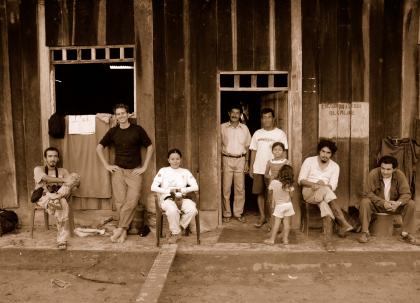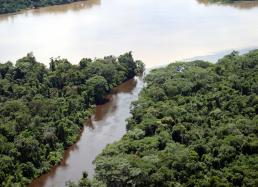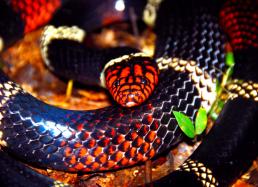9. Camp 5: Flooded Trails, Coral Snakes, & A Stingray
Saludos from Camp 5, Aguas Negras! On October 25th we had our first truly sunny day—yes, we can finally dry our clothes! Everyone has a bigger smile today; people’s spirits seem to get soggy after 20 days of wet clothes.
This site was on the edge of the proposed Huimeki Communal Reserve and was our only campsite close to the Putumayo, a major tributary of the Amazon. From the community of Tres Fronteras, at the confluence of the Güeppí and Putumayo Rivers, we walked 9.5 kilometers inland over several sandier terraces, a small swampy area, and finally a stretch of terra firme hills.
We camped on a hilltop approximately 40 meters above a blackwater stream, the Aguas Negras. Our trails followed the Aguas Negras stream and the seasonally inundated forest along its banks, traversed a series of small hills interspersed with small palm swamps in the flat-bottomed valleys in between, and crossed flatter terraces farther from the streambed.
There are small, temporary fishing and/or hunting camps along the banks of the Aguas Negras stream, as well as older more established hunting trails criss-crossing our trails. Our guides from Tres Fronteras knew this area well because they hunt here regularly.
Since the Advance Team cut the trails, water levels had risen by at least one meter, and the Aguas Negras stream had jumped its bank and completely flooded one of our trails. Both Debby Moskovits and I were the first to take this trail, and often we were walking through waist-deep water. Trying to follow the trail was nearly impossible, and often quite creepy (plunging into black water up to your waist in the Amazon is seriously sketchy).
As Debby was slogging through a long wet stretch, she felt a sharp spike drive into her ankle. When she got to one of the few dry spots, she saw a big slice in her boot, and when she pulled her foot out, it was bleeding. Turns out, she had gotten tagged by a freshwater ray, one of the most feared animals in the Amazon. She probably stepped on it when she was walking through the water. When Debby showed her foot to some of our guides from Tres Fronteras back at camp, they were deeply concerned and decided she had been lucky. If she could stand the pain, that meant it was probably a juvenile.
After this, all of us decided to shuffle our feet when walking through the waist deep water, although it was hard to shake an intense apprehensive feeling—especially after the next night, when the herpetologists caught an aquatic Coral Snake, Micrurus surinamensis, in those same waters! Several weeks after the inventory, my friend Harry Greene, an amazing herpetologist, told me that no anti-venin exists for this snake….
To learn about the reptiles and amphibians our herpetologists discovered during the inventory, take a look at “Video Report 7: Reptiles and Amphibians." Tomorrow we walk back to Tres Fronteras, where a plane awaits us, and we fly to Iquitos!
Corine
Written October 28, 2007





